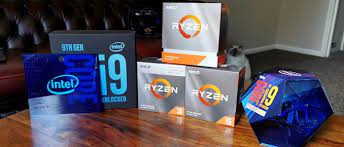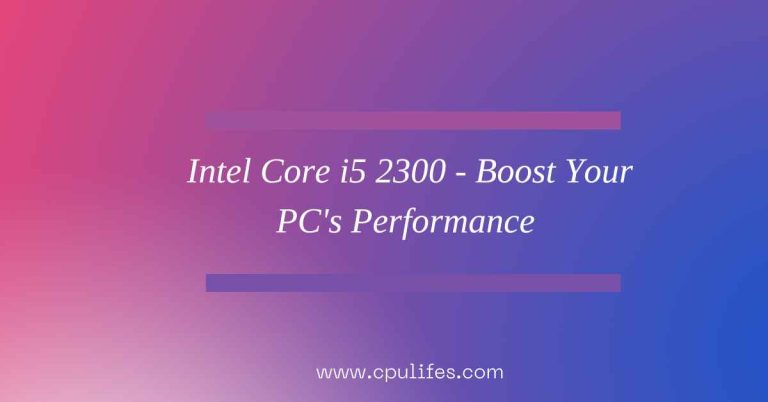What Is CPU IPC? – What Can It Do? How Does It Work In 2023
Instructions per clock ( is helpful work a processor gets done every time it clocks. It is a measure of the number of instructions that a processor can execute in one clock cycle.
In simple words, it is the cycles of instructions that can be completed in one clock cycle and measures how efficiently a processor can utilize its clock speed.
IPC is an essential metric for determining the overall performance of a processor, as it might be used to differentiate the performance of processors running at the same clock speed.
What is IPC about CPU, and how is it calculated?
IPC, or instructions per cycle, measures the number of instructions a processor can execute in one clock cycle.
This number is essential when evaluating the performance of a CPU, as it helps to determine the cycles of instructions per second and floating point operations for each second of the Processor.
The number of IPS and floating point operations per second are computed by multiplying the number of instructions each cycle with the clock rate (cycles each second given in Hertz) of the Processor in question.
The Processor can execute more instructions when its clock rate is higher. In other words, the higher the IPC, the more instructions the Processor can execute in a given amount of time, making it more efficient.
This calculation is a valuable tool for comparing the performance of different CPUs and determining which is the most efficient for a given task.
What Affects IPC?
By combining a high IPC and low clock speed or a low IPC and high clock speed, we can get the required level of instruction per second.
The AMD Athlon and early Intel Core Series processors are examples of the former. At the same time, the Intel Pentium 4 and the AMD Bulldozer are examples of the latter.
Factors that affect IPC include:
- The processor architecture.
- The number of cores.
- The instruction set.
- The cache size.
- The branch prediction accuracy.
- The cycles of instructions that can be carried out in parallel.
- The clock speed.
The higher the IPC, the more instructions can be processed within a given clock cycle.
What Are Some High IPC Options For Gamers?
Some of the highest IPC options available for gamers are Intel Core i7 and AMD Ryzen 7 processors.
These are the top-of-the-line offerings from both companies and offer the best performance for gaming.

For those on a tighter budget, the Intel Core i5 and AMD Ryzen 5 processors are also good options, providing decent performance at a more affordable price.
When looking for the best IPC (Instructions Per Cycle) options for gamers, there are a few factors to consider:
- The Processor should be powerful enough to handle the most demanding gaming applications.
- The graphics card should deliver smooth and realistic visuals.
- The RAM and storage capacity should be sufficient to store all the necessary files and data.
What Is The Average IPC Of CPUs?
Generally speaking, modern processors have an IPC of around 4-6, with some high-end models reaching up to.
Knowing the average IPC of CPUs is vital for those looking to sell gadgets as it helps them determine which processors are better suited for their customers’ needs.
Additionally, understanding the IPC of CPUs can help sellers better understand the performance of their products.
How Does IPC work?
The IPC of a CPU can be computed by running a set piece of code and calculating the number of machine-level instructions required to complete it. Then, high-performance timers measure the clock cycles required to complete it on the hardware.
This allows for the accurate calculation of IPC, the number of instructions completed in a single clock cycle.
This is an essential metric in measuring the performance of a processor, as it allows for a comparison of different processors and architectures.
By understanding how IPC works, engineers and developers can better optimize their code and make sure their applications run as efficiently as possible.
Which Processor Currently Has The Highest IPC?
The Processor with the highest IPC is a VLIW (Very Long Instruction Word) design. This type of Processor can issue many parallel instructions with minimal or no dependency checking or interlocking.
This allows for a higher IPC (Instructions Per Cycle) than other processor designs. Joe Zbiciak has mentioned this type of Processor as amongst the most powerful and efficient designs.
It is ideal for applications requiring high-speed processing, as the VLIW design allows for more instructions to be processed in a shorter time.
This makes it the ideal choice for applications that require a high degree of performance.
Can we compare 2 CPUs’ IPC?
In short, no. IPC (instructions per cycle) measures a CPU’s performance but needs to be a definitive metric.
It is an array of values that can be used to differentiate the performance of two CPUs at a given clock speed, but it doesn’t give you an overall performance rating for either Processor.
IPC is an essential factor to consider when comparing CPUs, but there are others. Factors like cache size, number of cores, and memory bandwidth all play a role in determining a CPU’s overall performance.
Ultimately, only so many metrics can definitively compare two CPUs’ performance.
Benefits of using IPC:
CPU IPC is an essential metric for performance analysis. Processes with higher CPU IPC are more responsive and efficient overall.
Additionally, CPU IPC can measure the amount of work a process is doing, allowing for the optimization of code and identification of bottlenecks.
The benefits of using IPC(instructions per cycle) are clear, as it provides a way to measure the performance of a system and improve it where needed.
CPU IPC can be used in many different scenarios, from gaming to server-side applications, and is an invaluable metric for performance analysis.
Demerits of using CPU IPC:
The demerits of using CPU IPC are numerous. Creating custom code libraries that use IPC can be expensive, time-consuming, and resource-intensive, leading to a decrease in overall performance.
Additionally, IPC can lead to code vulnerabilities if not implemented correctly, resulting in potential security risks.
Communication issues between threads can also arise due to IPC, leading to instability and potential crashes. Furthermore, IPC can be difficult to debug and maintain, adding further costs to the development process.
Conclusion
In a nutshell, IPC is a performance metric that measures how many instructions a processor can execute in one clock cycle.
A higher IPC indicates that the Processor can carry out more work in the same amount of time, meaning it is a more efficient processor.
A low IPC indicates that the Processor is not as efficient and may need to be replaced or upgraded.
Related Posts:






